Long-Term Trends and Variability of Hydroclimate Variables and Their Linkages with Climate Indices in the Songhua River
Abstract
:1. Introduction
2. Materials and Methods
2.1. Study Region
2.2. Datasets
2.2.1. Climate Data
2.2.2. Streamflow Data
2.2.3. Climate Indices
2.3. Trend Methods
2.3.1. Linear Trend Method
2.3.2. Mann–Kendall (MK) Test
2.3.3. Two-Period Method and Innovative Trend Analysis (ITA)
3. Results
3.1. Long-Term Variability and Trends of Annual Precipitatiion, Temperature, and Streamflow
3.2. Relationship between Streamflow and Precipitation
3.3. Monthly Trends of Precipitation, Temperature, and Streamflow
3.4. Linkages between Hydroclimate Variability and Climate Indices
4. Discussion
4.1. Comparison with Existing Studies
4.2. Spatial Heterogeneity
4.3. Regional vs. Global Warming
4.4. Trend Methods
5. Conclusions
- There was an obvious pattern of decadal oscillations for the annual total precipitation and streamflow, with three positive and three negative anomalies in the last 122 years (Figure 2).
- Annual mean temperature demonstrated a statistically significant increasing trend in the last 122 years and the trend magnitude was 0.30 °C/10 years in the last 50–60 years, being larger than that of the global land surface temperature. It has increased much faster since 1970.
- Time series of the annual runoff coefficient did not show a declining trend given the regional development of more water usage and population growth. However, the correlations between annual total precipitation and streamflow did vary with time. It could partly contribute to the lower rainfall and smaller runoff coefficients during the 1901–1930 period, but also potentially resulted from other reasons, such as a warmer climate resulting in more streamflow from snowmelt.
- Winter monthly precipitation in recent years was almost the same as in the earlier periods, but an increasing monthly streamflow was observed. It was a result of more snowmelt under a warming climate.
- A statistically significant correlation between the hydroclimate variables (annual total precipitation and streamflow) and climate indices (SOI, PDO, and IPO) was determined.
- The SHR displayed a similar warming trend to the global land surface, especially since 1970. However, the global land surface mean temperature has been increasing in the recent 10–15 years but not for the SHR. The top-eight hottest years for the global land surface were all after 2015, but the hottest year in the SHR was the 2007.
- Three trend methods employed in this study showed similar results, but differences were also observed. A general conclusion would be that all models should be used to quantify the uncertainty, and consistent results certainly enhance our confidence in the results and conclusions.
- The ITA method is less robust and popular than the non-parametric MK test and the linear regression, but it can provide additional information on the trends at different percentiles (Figure 10).
- One major difference and advantage of this current research compared to those existing studies is that a much longer study period was used. It presented a full picture of temporal variability of hydroclimate variables, such as the decadal oscillations with positive and negative anomalies of annual precipitation and streamflow. It implies the potential caveats and limitations of existing studies with a shorter study period. For example, an increasing or decreasing trend of annual total precipitation and streamflow might be identified with a 50-year study period, but this trend has limited practical applications for regional water resource management given the long-term temporal variability.
- The results of this study can not only be used for better water resource management decisions in the SHR, but also have implications for other regions in the world for comparative analysis.
- There are some uncertainties and caveats associated with the results of this study which need further investigation to draw a solid conclusion.
Author Contributions
Funding
Institutional Review Board Statement
Informed Consent Statement
Data Availability Statement
Acknowledgments
Conflicts of Interest
References
- IPCC. Summary for Policymakers. In Climate Change 2023: Synthesis Report. Contribution of Working Groups I, II and III to the Sixth Assessment Report of the Intergovernmental Panel on Climate Change; Core Writing Team, Lee, H., Romero, J., Eds.; IPCC: Geneva, Switzerland, 2023; p. 34. [Google Scholar]
- Li, F.P.; Zhang, G.X.; Xu, Y.J. Spatiotemporal variability of climate and streamflow in the Songhua River. Basin, northeast China. J. Hydrol. 2014, 514, 53–64. [Google Scholar] [CrossRef]
- Miao, C.Y.; Yang, L.; Liu, B.Y.; Gao, Y.; Li, S.L. Streamflow changes and its influencing factors in the mainstream of the Songhua River basin, Northeast China over the past 50 years. Environ. Earth Sci. 2011, 63, 489–499. [Google Scholar] [CrossRef]
- Wang, S.J.; Wang, Y.J.; Ran, L.S.; Su, T. Climatic and anthropogenic impacts on runoff changes in the Songhua River basin over the last 56 years (1955–2010), Northeastern China. Catena 2015, 127, 258–269. [Google Scholar] [CrossRef]
- Yin, S.H.; Gao, G.Y.; Huang, A.Q.; Li, D.F.; Ran, L.S.; Nawaz, M.; Xu, Y.J.; Fu, B.J. Streamflow and sediment load changes from China’s large rivers: Quantitative contributions of climate and human activity factors. Sci. Total Environ. 2023, 876, 162758. [Google Scholar] [CrossRef] [PubMed]
- Khan, M.I.; Liu, D.; Fu, Q.; Azmat, M.; Luo, M.J.; Hu, Y.X.; Zhang, Y.J.; Abrar, F.M. Precipitation variability assessment of northeast China: Songhua River basin. J. Earth Syst. Sci. 2016, 125, 957–968. [Google Scholar] [CrossRef]
- Faiz, M.A.; Liu, D.; Fu, Q.; Qamar, M.U.; Dong, S.; Khan, M.I.; Li, T. Complexity and trends analysis of hydrometeorological time series for a river streamflow: A case study of Songhua River Basin, China. River Res. Appl. 2018, 34, 101–111. [Google Scholar] [CrossRef]
- Su, L.; Miao, C.Y.; Gou, J.J. Long-term trends in Songhua River Basin streamflow and its multivariate relationships with meteorological factors. Environ. Sci. Pollut. Res. 2021, 28, 64206–64219. [Google Scholar] [CrossRef]
- Liu, S.Q.; Zhou, Z.H.; Liu, J.J.; Li, J.; Wang, P.X.; Li, C.M.; Xie, X.M.; Jia, Y.W.; Wang, H. Analysis of the Runoff Component Variation Mechanisms in the Cold Region of Northeastern China under Climate Change. Water 2022, 14, 3170. [Google Scholar] [CrossRef]
- Ren, G.Y.; Ding, Y.H.; Zhao, Z.C.; Zheng, J.Y.; Wu, T.W.; Tang, G.L.; Xu, Y. Recent progress in studies of climate change in China. Adv. Atmos. Sci. 2012, 29, 958–977. [Google Scholar] [CrossRef]
- Zhou, Z.; Shi, H.; Fu, Q.; Li, T.; Gan, T.Y.; Liu, S.; Liu, K. Is the cold region in Northeast China still getting warmer under climate change impact? Atmos. Res. 2020, 237, 104864. [Google Scholar] [CrossRef]
- Yan, X.H.; Boyer, T.; Trenberth, K.; Karl, T.R.; Xie, S.P.; Nieves, V.; Tung, K.K.; Roemmich, D. The global warming hiatus: Slowdown or redistribution? Earths Future 2016, 4, 472–482. [Google Scholar] [CrossRef]
- Peng, S.Z.; Ding, Y.X.; Liu, W.Z.; Li, Z. 1 km monthly temperature and precipitation dataset for China from 1901 to 2017. Earth Syst. Sci. Data 2019, 11, 1931–1946. [Google Scholar] [CrossRef]
- Harris, I.; Jones, P.D.; Osborn, T.J.; Lister, D.H. Updated high-resolution grids of monthly climatic observations—The CRU TS3.10 Dataset. Int. J. Climatol. 2014, 34, 623–642. [Google Scholar] [CrossRef]
- Harris, I.; Osborn, T.J.; Jones, P.; Lister, D. Version 4 of the CRU TS monthly high-resolution gridded multivariate climate dataset. Sci. Data 2020, 7, 109. [Google Scholar] [CrossRef]
- Ouyang, R.; Liu, W.; Fu, G.; Liu, C.; Hu, L.; Wang, H. Linkages between ENSO/PDO signals and precipitation, streamflow in China during the last 100 years. Hydrol. Earth Syst. Sci. 2014, 18, 3651–3661. [Google Scholar] [CrossRef]
- Zhang, Y.; Wallace, J.M.; Battisti, D.S. ENSO-like interdecadal variability: 1900–93. J. Clim. 1997, 10, 1004–1020. [Google Scholar] [CrossRef]
- Mantua, N.J.; Hare, S.R.; Zhang, Y.; Wallace, J.M.; Francis, R.C. A Pacific interdecadal climate oscillation with impacts on salmon production. Bull. Am. Meteorol. Soc. 1997, 78, 1069–1079. [Google Scholar] [CrossRef]
- Salinger, M.J.; Renwick, J.A.; Mullan, A.B. Interdecadal Pacific Oscillation and South Pacific climate. Int. J. Climatol. 2001, 21, 1705–1721. [Google Scholar] [CrossRef]
- Henley, B.J.; Gergis, J.; Karoly, D.J.; Power, S.; Kennedy, J.; Folland, C.K. A Tripole Index for the Interdecadal Pacific Oscillation. Clim. Dyn. 2015, 45, 3077–3090. [Google Scholar] [CrossRef]
- Fu, G.B.; Rojas, R.; Gonzalez, D. Trends in Groundwater Levels in Alluvial Aquifers of the Murray-Darling Basin and Their Attributions. Water 2022, 14, 1808. [Google Scholar] [CrossRef]
- Hirsch, R.M.; Slack, J.R.; Smith, R.A. Techniques of Trend Analysis for Monthly Water-Quality Data. Water Resour. Res. 1982, 18, 107–121. [Google Scholar] [CrossRef]
- Kendall, M.G. Rank Correlation Methods, 4th ed.; Charles Griffin: London, UK, 1975. [Google Scholar]
- Fu, G.B.; Chen, S.L.; Liu, C.M.; Shepard, D. Hydro-climatic trends of the Yellow River basin for the last 50 years. Clim. Chang. 2004, 65, 149–178. [Google Scholar] [CrossRef]
- Sen, P.K. Estimates of Regression Coefficient Based on Kendalls Tau. J. Am. Stat. Assoc. 1968, 63, 1379–1389. [Google Scholar] [CrossRef]
- Sen, Z. Innovative Trend Analysis Methodology. J. Hydrol. Eng. 2012, 17, 1042–1046. [Google Scholar] [CrossRef]
- Li, Z.; Wu, Y.; Li, J.; Qi, P.; Sun, J.; Sun, Y. Attribution Analysis of Runoff Variation in the Second Songhua River Based on the Non-Steady Budyko Framework. Water 2023, 15, 451. [Google Scholar] [CrossRef]
- Wei, Y.L.; Li, X.F.; Gu, L.J.; Zheng, Z.J.; Zheng, X.M.; Jiang, T. Significant decreasing trends in snow cover and duration in Northeast China during the past 40 years from 1980 to 2020. J. Hydrol. 2023, 626, 130318. [Google Scholar] [CrossRef]
- Fu, G.B.; Charles, S.P.; Chiew, F.H.S. A two-parameter climate elasticity of streamflow index to assess climate change effects on annual streamflow. Water Resour. Res. 2007, 43, W11419. [Google Scholar] [CrossRef]
- Trenberth, K.E. The definition of El Nino. Bull. Am. Meteorol. Soc. 1997, 78, 2771–2777. [Google Scholar] [CrossRef]

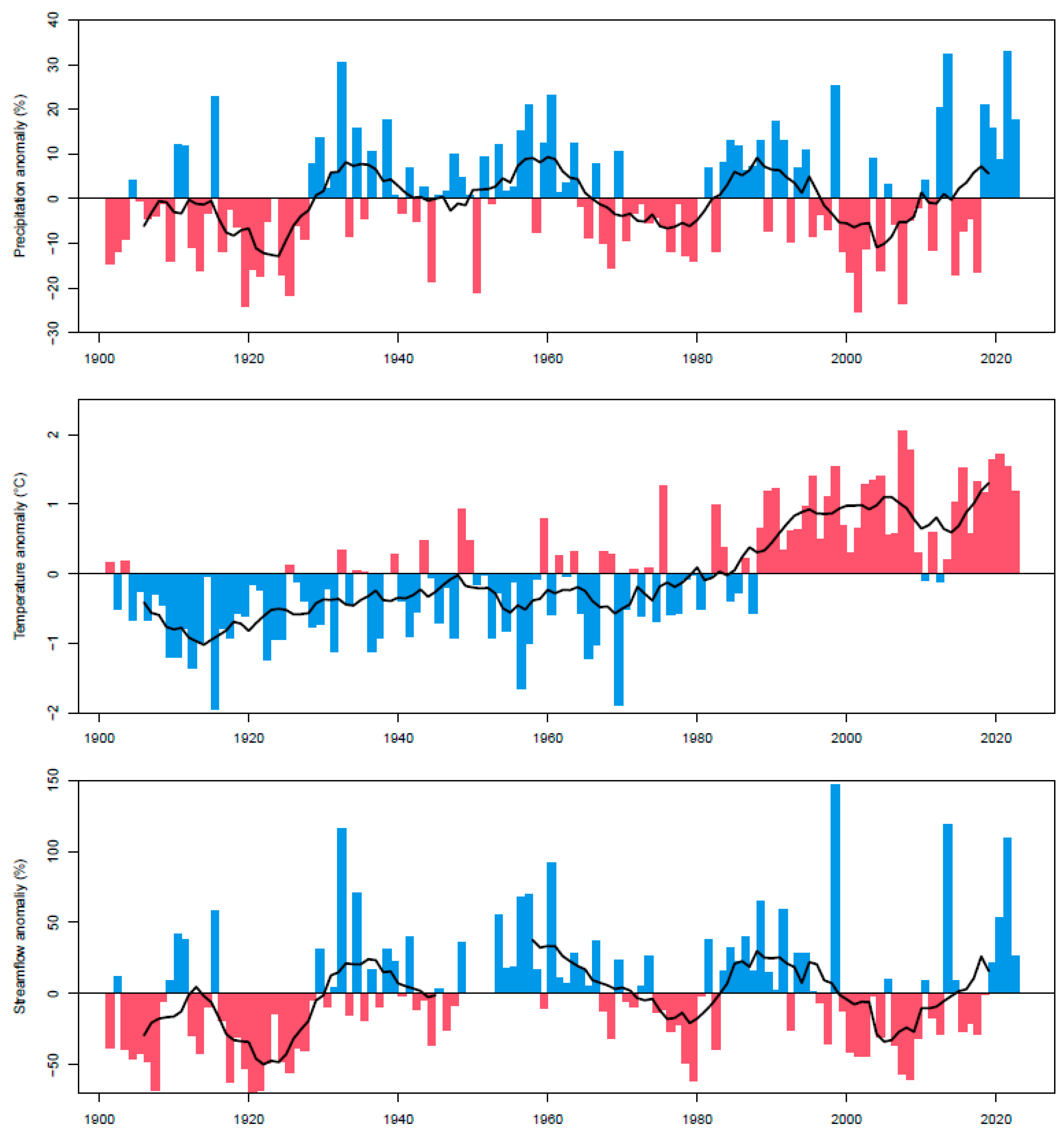


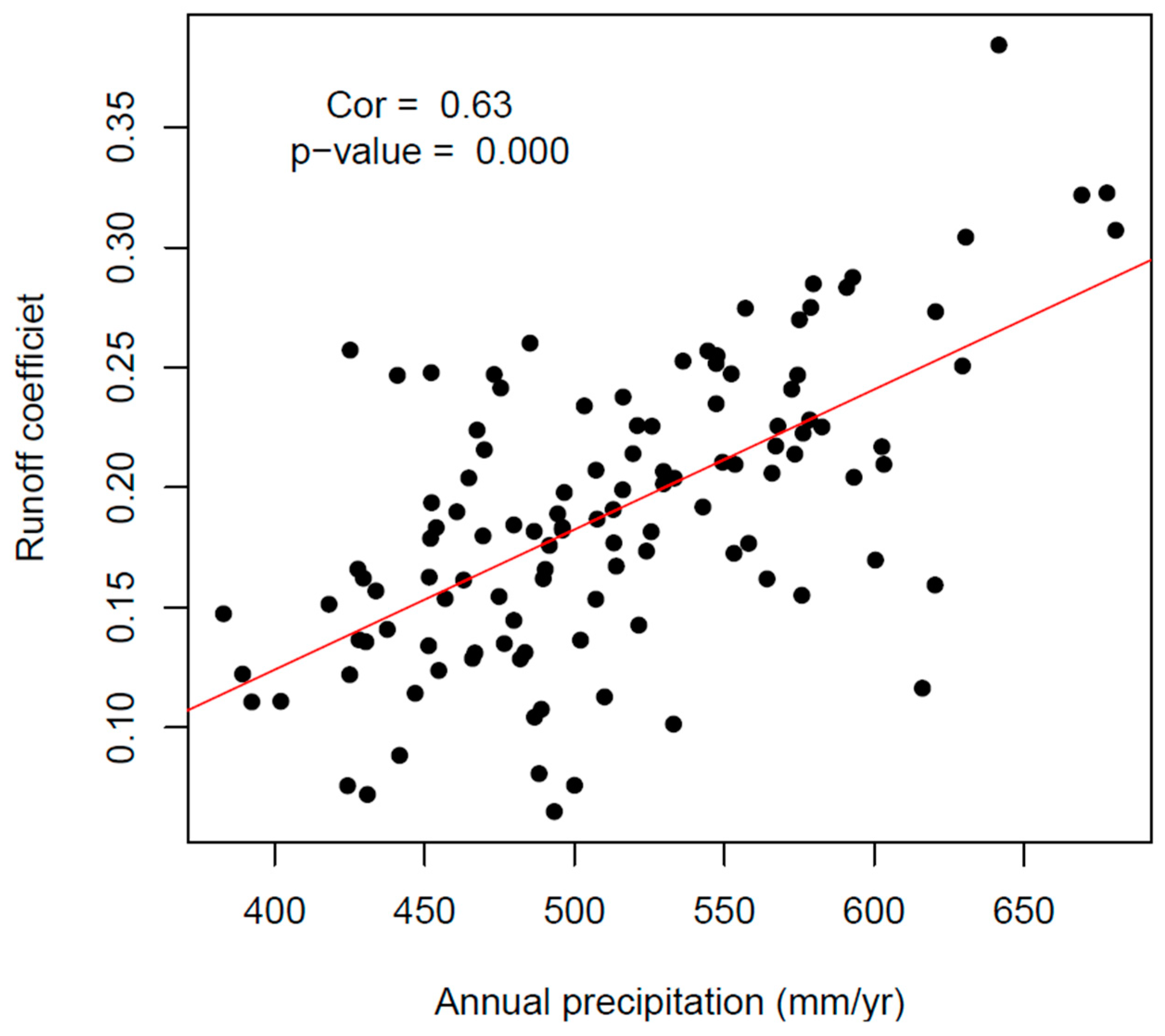
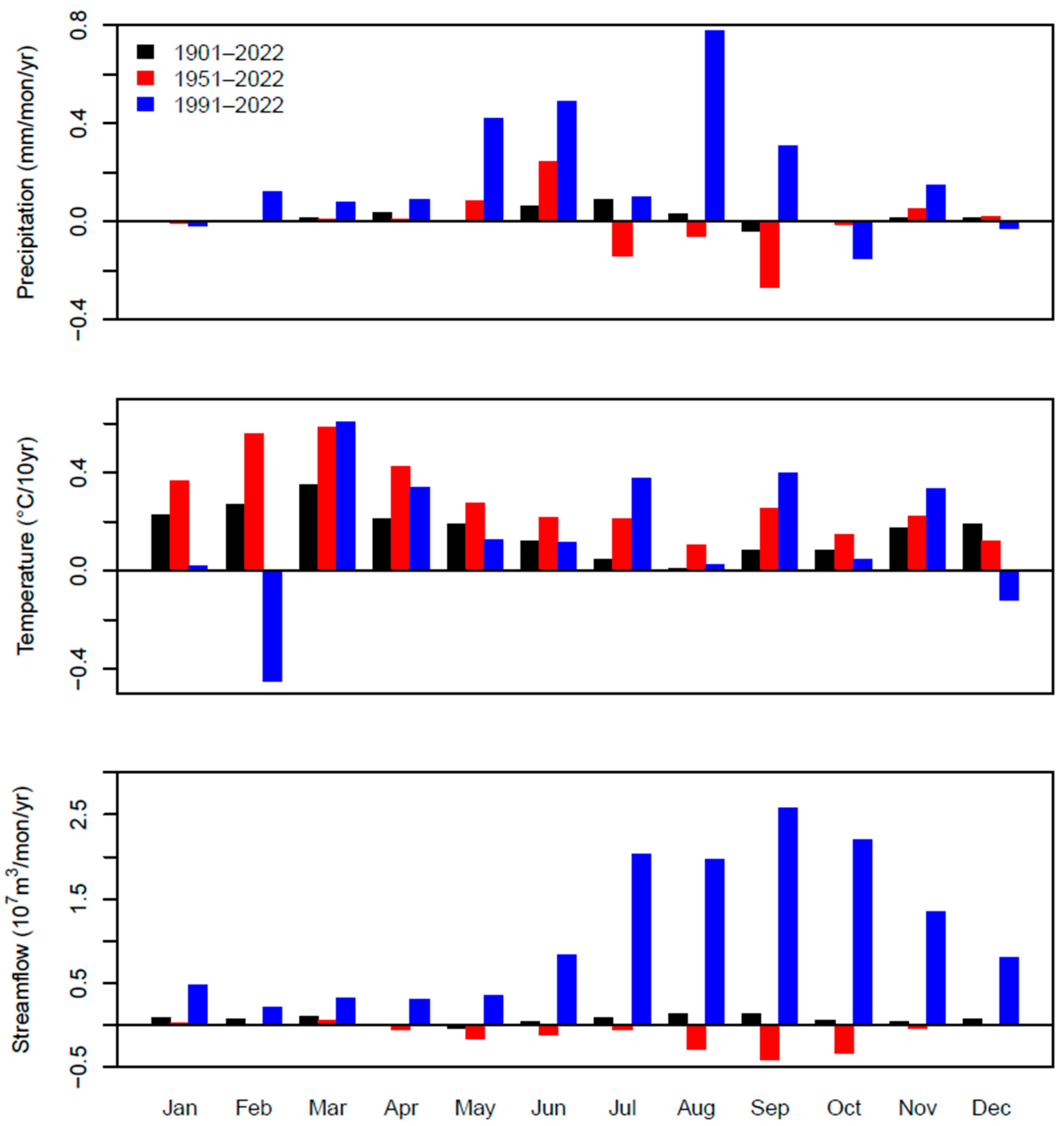
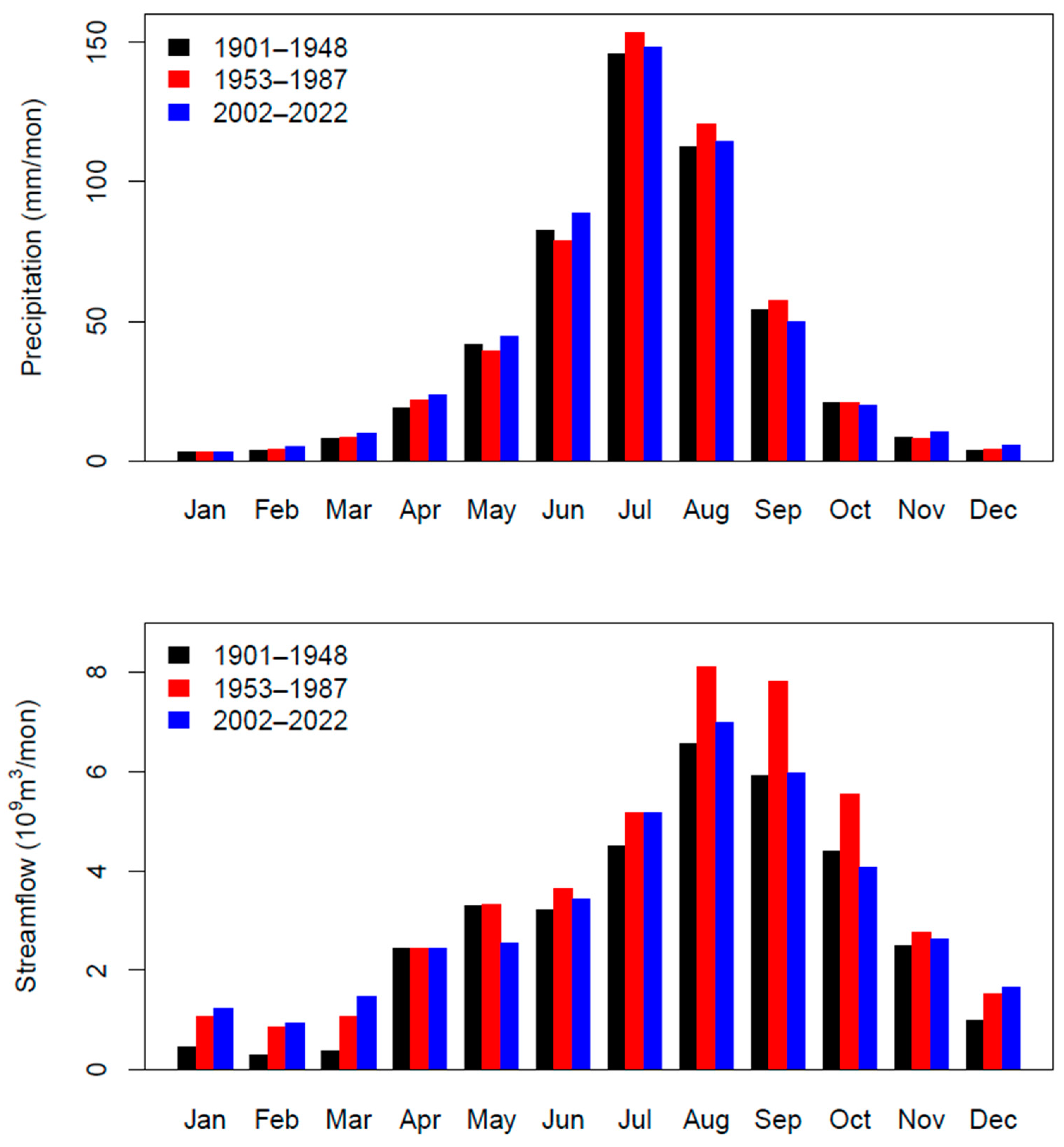
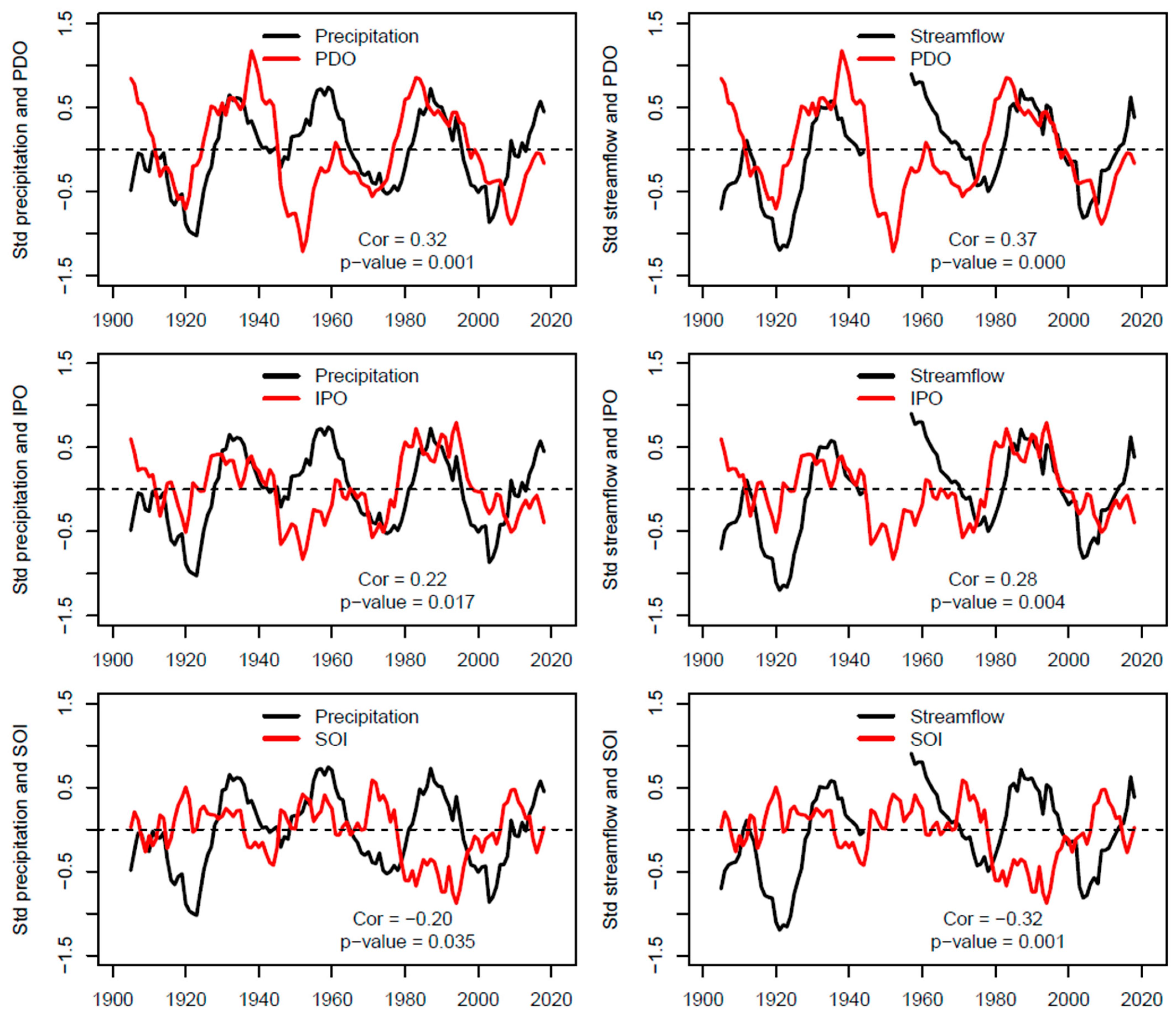

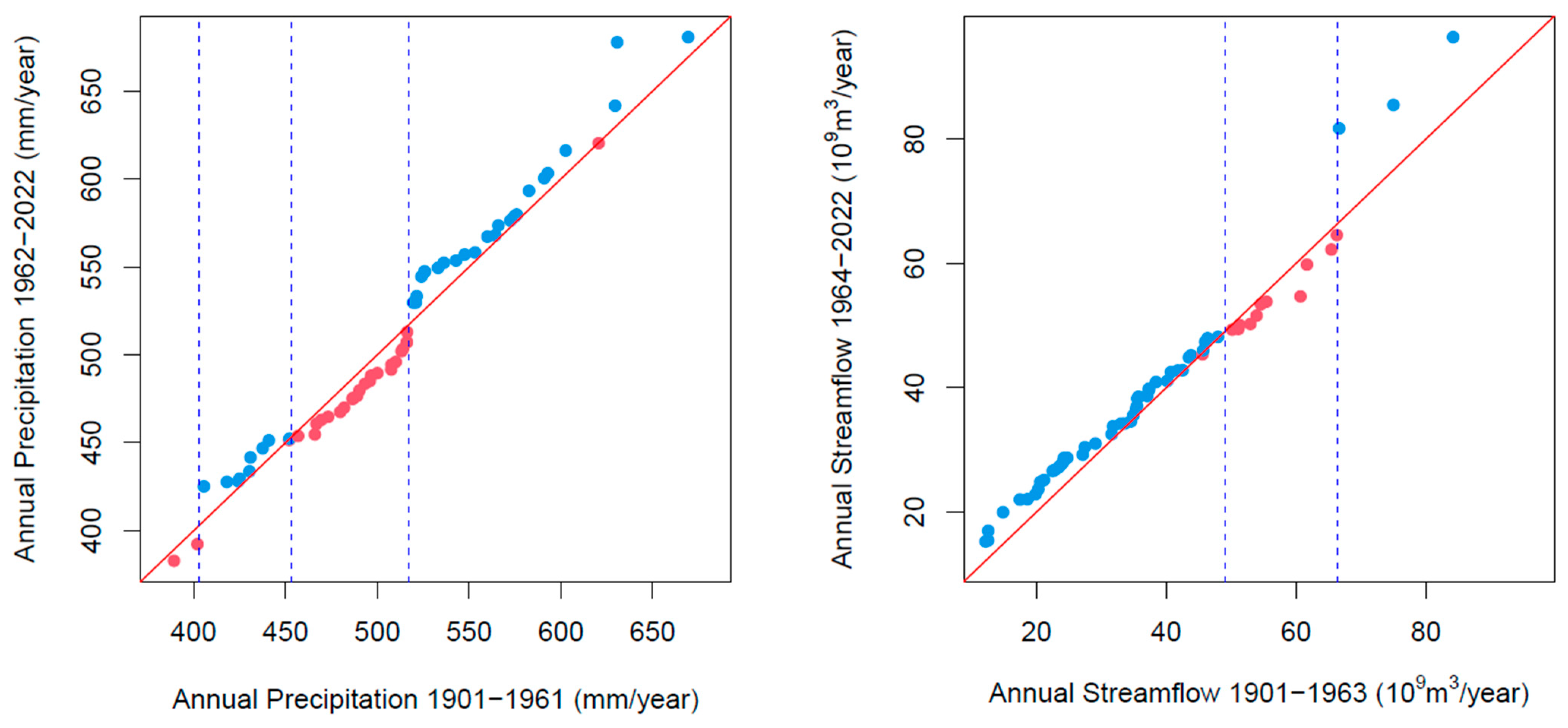
| Period | Precipitation | Temperature | Streamflow | ||||||
|---|---|---|---|---|---|---|---|---|---|
| MK | Linear | ITA | MK | Linear | ITA | MK | Linear | ITA | |
| 1901–2022 | 0.18 | 0.12 | 0.86 | 0.00 | 0.00 | 0.00 | 0.07 | 0.04 | 0.41 |
| 1911–2022 | 0.39 | 0.26 | 0.74 | 0.00 | 0.00 | 0.00 | 0.30 | 0.18 | 0.92 |
| 1921–2022 | 0.91 | 0.65 | 0.72 | 0.00 | 0.00 | 0.00 | 0.96 | 0.60 | 0.62 |
| 1931–2022 | 0.39 | 0.62 | 0.74 | 0.00 | 0.00 | 0.00 | 0.07 | 0.24 | 0.21 |
| 1941–2022 | 0.82 | 0.79 | 0.56 | 0.00 | 0.00 | 0.00 | 0.13 | 0.52 | 0.87 |
| 1951–2022 | 0.54 | 0.89 | 0.96 | 0.00 | 0.00 | 0.00 | 0.04 | 0.26 | 0.57 |
| 1961–2022 | 0.45 | 0.22 | 0.98 | 0.00 | 0.00 | 0.00 | 0.46 | 0.82 | 0.60 |
| 1971–2022 | 0.35 | 0.18 | 0.97 | 0.00 | 0.00 | 0.00 | 0.97 | 0.53 | 0.66 |
| 1981–2022 | 0.95 | 0.75 | 0.94 | 0.00 | 0.00 | 0.02 | 0.25 | 0.71 | 0.27 |
| 1991–2022 | 0.24 | 0.13 | 0.21 | 0.16 | 0.18 | 0.44 | 0.59 | 0.60 | 0.79 |
| Period | Precipitation (mm/Year2) | Temperature (°C/10 Year) | Streamflow (108 m3/Year2) | ||||||
|---|---|---|---|---|---|---|---|---|---|
| MK | Linear | ITA | MK | Linear | ITA | MK | Linear | ITA | |
| 1901–2022 | 0.25 | 0.26 | 0.03 | 0.16 | 0.16 | 0.15 | 0.72 | 0.86 | 0.41 |
| 1911–2022 | 0.20 | 0.22 | −0.07 | 0.18 | 0.18 | 0.18 | 0.49 | 0.65 | −0.06 |
| 1921–2022 | 0.04 | 0.10 | −0.09 | 0.19 | 0.19 | 0.20 | 0.03 | 0.29 | −0.31 |
| 1931–2022 | −0.28 | −0.13 | −0.10 | 0.20 | 0.20 | 0.22 | −1.07 | −0.75 | −0.91 |
| 1941–2022 | −0.09 | 0.08 | 0.20 | 0.24 | 0.23 | 0.27 | −1.11 | −0.50 | −0.14 |
| 1951–2022 | −0.29 | −0.05 | −0.02 | 0.29 | 0.29 | 0.33 | −1.83 | −1.09 | −0.61 |
| 1961–2022 | 0.44 | 0.59 | −0.01 | 0.30 | 0.30 | 0.33 | −0.76 | 0.27 | −0.68 |
| 1971–2022 | 0.69 | 0.87 | −0.03 | 0.31 | 0.30 | 0.29 | −0.16 | 1.01 | −0.82 |
| 1981–2022 | 0.09 | 0.31 | 0.08 | 0.25 | 0.23 | 0.21 | −2.22 | −0.88 | −2.95 |
| 1991–2022 | 2.15 | 2.35 | 2.25 | 0.18 | 0.15 | 0.10 | 2.49 | 2.03 | 1.21 |
| 1969–2008 | 0.55 | 0.53 | 0.58 | ||||||
| Period | Streamflow Anomaly (%) | Precipitation Anomaly (%) | Elasticity |
|---|---|---|---|
| 1901–1928 | −27.0 | −6.0 | 4.5 |
| 1929–1966 | 19.5 | 4.4 | 4.4 |
| 1967–1982 | −11.9 | −5.5 | 2.1 |
| 1983–1998 | 25.4 | 6.0 | 4.2 |
| 1999–2012 | −27.4 | −6.5 | 4.2 |
| 2013–2022 | 26.2 | 8.3 | 3.2 |
Disclaimer/Publisher’s Note: The statements, opinions and data contained in all publications are solely those of the individual author(s) and contributor(s) and not of MDPI and/or the editor(s). MDPI and/or the editor(s) disclaim responsibility for any injury to people or property resulting from any ideas, methods, instructions or products referred to in the content. |
© 2024 by the authors. Licensee MDPI, Basel, Switzerland. This article is an open access article distributed under the terms and conditions of the Creative Commons Attribution (CC BY) license (https://creativecommons.org/licenses/by/4.0/).
Share and Cite
Ma, C.; Pei, W.; Liu, J.; Fu, G. Long-Term Trends and Variability of Hydroclimate Variables and Their Linkages with Climate Indices in the Songhua River. Atmosphere 2024, 15, 174. https://doi.org/10.3390/atmos15020174
Ma C, Pei W, Liu J, Fu G. Long-Term Trends and Variability of Hydroclimate Variables and Their Linkages with Climate Indices in the Songhua River. Atmosphere. 2024; 15(2):174. https://doi.org/10.3390/atmos15020174
Chicago/Turabian StyleMa, Chongya, Wenhan Pei, Jiping Liu, and Guobin Fu. 2024. "Long-Term Trends and Variability of Hydroclimate Variables and Their Linkages with Climate Indices in the Songhua River" Atmosphere 15, no. 2: 174. https://doi.org/10.3390/atmos15020174
APA StyleMa, C., Pei, W., Liu, J., & Fu, G. (2024). Long-Term Trends and Variability of Hydroclimate Variables and Their Linkages with Climate Indices in the Songhua River. Atmosphere, 15(2), 174. https://doi.org/10.3390/atmos15020174











